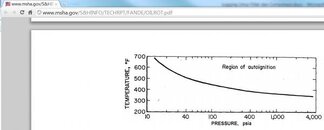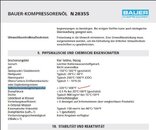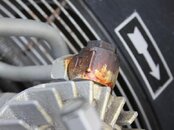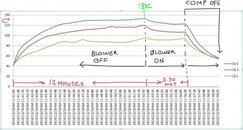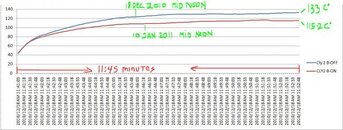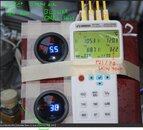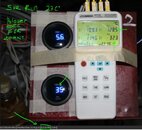Peace and peace and no war please.
I read the link Frogman, it is about regulators for use up to 40% 02, and not about cont-blend of Nitrox using oil lubricated compressor.
I have zero fear of using Nitrox up to 40% but I am worried if I am to be the one making them by doing cont-blend on my Bauer, that is the question I need to get the answer for.
I have no doubt LF MA64 is approved for Nitrox blending, but surely it is partial blending and not cont-blend.
Exactly why I raised this question about CONT-BLEND and not partial blending.
Hyper Filters are for downstream of all stages of compressions, it then clean the air to Super Clean Air nearly oil-free.
My question is, my Bauer needs ambient air, even though I feed super clean air ( assumed it is possible ), my Bauer introduces the oil mist at stage 1, and some minor natural design leak of floating piston oil in stage 3. That reality of oil-in-air..... I can not escape no matter what. So I am violating the very clean rule of nearly oil-free air when I mix say Nitrox 32%. The output of my compressor probably can deliver Nitrox approved air by any world standard when it is tested at the scuba tank, but I can't comply while making that Nitrox mix. So where is the safety for me , the Nitrox maker ?
So won't it be fair, as to not confuse us compressor owners, filter manufacturers who have Nitrox approved/legal or whatever Hyper filtration system it is called, should warned us that it is for
PARTIAL BLENDING ONLY and not for continuous blending in an oil lubricated compressor.
Isn't it an irony, that the dive industry set Nitrox's air oil level so very low, because they know it has to be that clean due to the involved danger (
nothing to do with our lungs being scattered with X amount of oil mist or Y amount fine dirt particles a CGA Grade D/E air still allows ) of higher oxygen level in the Nitrox mix. If it weren't for that danger, we would be pumping 50-70% oxygen with our Bauer. Yet some compressor manufacturer advertised that it is OK to cont-blend up to 40% oxgyen in their oil lubricated compressor ???

Where is the logic in that ? That is what I was dying to know and created this post.
Now simple logic.
Let say I want 40% Nitrox/EAN mix in my tank. Industry standard said my tank must super clean of oil traces because of safety. OK, I clean my tank super clean. DONE.
And then compressor manufacturer said, I can pump up to 40% oxygen using cont-blend devices on their oil-lubricated compressor. OK, I buy the mixing stick and etc etc. DONE
I then must buy special Hyper Filters because I must not mix air having oil trace higher than 0.1 mg/L when making Nitrox, its wrong and dangerous. OK me buy hyper filter. DONE
I then want to start making 40% Nitrox using cont-blend and I must use the mixing stick. OK.
I inject 99% oxygen into my a mixing stick and its metered to produce 40% Nitrox and it goes to my 1st stage. OK.
When my compressor starts running......I will ask myself, what am I doing injecting high 40% oxygen level to a super dirty 1st stage compression, which has breather running to crankcase and sucking oil mist into the 1st stage

If I can be safe pumping dirty oil air with high oxygen level in my compressor stages, why do I need a hyper filter then ?
What extra safety do I get from hyper filters, for cont-blend ? Nothing, no added safety, just added cost.
That was why I asked , how do I cont-blend with my Bauer ?

Tanks with 40% nitrox is OK, me not scared because even in the hottest of my climate, my tanks will not exceed 60C for sure being under the sun, me do not use black color tanks. However, I am scared to have 40% oxygen in my compressor because I have cylinder head temperature sensors on all 3 heads. I can read easy 133C 2nd stage exhaust pipe exterior temperature within 20 minutes of a Mariner 200 running at 32 ambient temperature, God knows what is the real compression air temperature peak inside all 3 compression chambers. Bauer electronics will shut comp down when it hits 135C at 3rd stage, little do they realized or care to realize that K 120 II block is hottest at 2nd stage. Mine has no Bauer electronics, so I install my own and a more accurate one with data logging capability.
I also know oil auto ignition temperature ( AIT ) at elevated ambient pressure like inside the 2nd and 3rd stage, can burn well below its AIT which is tested at 1 ATM. A 365 Celcius AIT ( 1 ATM ) of a good compressor oil, at mere 30BAR (this is refrigeration compressor, thus low pressure ) drops to down to 215 Celcius.
Auto-ignition of lubricating oil working at h... [J Hazard Mater. 2011] - PubMed - NCBI
This is the scarry bit :
"They are close to flash point temperature and the lubricating oil can be hazardous when it works for high-pressure operating condition and abundant air flows into a compressor."
I seen lower oil AIT figures at elevated pressure from a study of a Mine accident involving higher pressure compressor to feed a Mine working tools. See attachment.
Got another one and interesting :
Mitigating Explosion Risks in High Pressure Air Injection Compressors
Using an Accelerating Rate Calorimeter (ARC), samples of fresh and used synthetic lubricants were heated in the presence of air at initial pressures up to 34.5 MPa (5,000 psi). Self-heating rates and pressure responses were measured.
The results highlighted the significant effect of pressure on auto-ignition temperature. Most significantly, the auto-ignition temperature of the diester-based lubricant dropped from the manufacturer's reported level of 410 °C (770 °F) at atmospheric pressure to 180 °C (365 °F) at pressures in the range of 17.2 to 34.5 MPa (2,500 to 5,000 psi). Also, the auto-ignition temperature of used (oxidized) synthetic lubricant was further reduced to values close to the operating temperature levels of the compressors. Finally, it was noted that the auto-ignition temperatures for different brands of diester-based lubricants were all very similar.
The significance of this study is not only in the temperature data, but also in the discussion of several significant changes that Encore made to the design and operation of their high pressure air compressors as a result of this study. This information will assist future HPAI operators in designing safe and reliable air compression systems.
Chemlube 800 AIT is 391 Celcius and flash point is 279 Celcius.
http://www.ultracheminc.com/productimages/thumb/CMS/Files/CHEMLUBE_800.pdf
Attached Bauer's synthetic oil AIT
The heat of compression with 21% oxygen scares me, because I have a digital temp logger and permanent install the sensors on all 3 cylinder head temp. Me don't have the one which can read compressed air temp, but probably I am one of the rare person to actually logged a compressor cylinder heat temp for the sake of learning. I mean the 1st year of installation I have hundreds hours worth of temp data logging. Now I know the temp profile and use the digital temp logger as meter only. The answer is obvious, me need 3000ish CFM ( 80 M3 per minute ) blower with good static pressure to cool my Marine 200. Without it, compressor can not be operated, PERIOD. That blower has power of approx 200% of the Bauer original pulley fan, probably more. The total amount of heat sink surface area on Bauer cylinder heads is not enough to cool by Bauer slow pulley fan in 30C ambient temperature. The only way I can improve cooling is to exceed Bauer's pulley fan air velocity so that I move more heat away by speeding the airflow.
See the temperature rise graphs attached.
PHOTO
My own compressor. In a compressor cubicle.
The two yellow digital temp data logger legend :
T = Tower, which is the final water separator of a Bauer P41
1 = Cylinder Head 1
2 = Cylinder Head 2
3 = Cylinder Head 3
PHOTO
My friend's compressor. Totally open air, meaning open air car park.
The single digital temp 4 channel data logger legend
T 4 = PZero as final water separator, skin temperature.
T1 to T3 are the cylinder heads temp respectively
I know extra heat will be generated when doing cont-blending up to 40% mix, that is the scariest bit because of known oil AIT decreasing at high ambient pressure. The reason I dare not cont-blend until today , even though I am seeing people doing it for years and years and no explosion.
I attached a Mariner 200 with a burnt out 2nd stage pipe fitting. Nope, no Nitrox making on this. I just want to show you guys the potential heat generated by our dive compressor, in 30 - 32 Celcius ambient temp and long running hours, plus probably not 100% open air kind of proper ventilation.
The brown residue is burnt oil. Go figure how hot did the oil get to be burned or how low the actual oil AIT at a mere 50 BAR or +-750 psi inside a 2nd stage. How did the oil leaked out ? The oil could leak out because that fitting and only that fitting on Bauer K120 II block, uses o-ring for easy installation of that elbow. Its o-ring is 200 celcius rating, so how did the o-ring leak.........? Because it was burned by the heat and maybe by the oil. I dont know. All I know is, HELL that is real hot to have happened that way.

With all this I am seeing, I then asked HOW DO I CONT-BLEND USING OIL-LUBRICATED COMPRESSOR ??
Good that the US Navy Manual answered my question once and for all.
There is no way US Navy does not know oil reduced AIT at high pressure. They even have their own Mil Spec oil standard.
Thanks Gentlemen.
IYA
.





